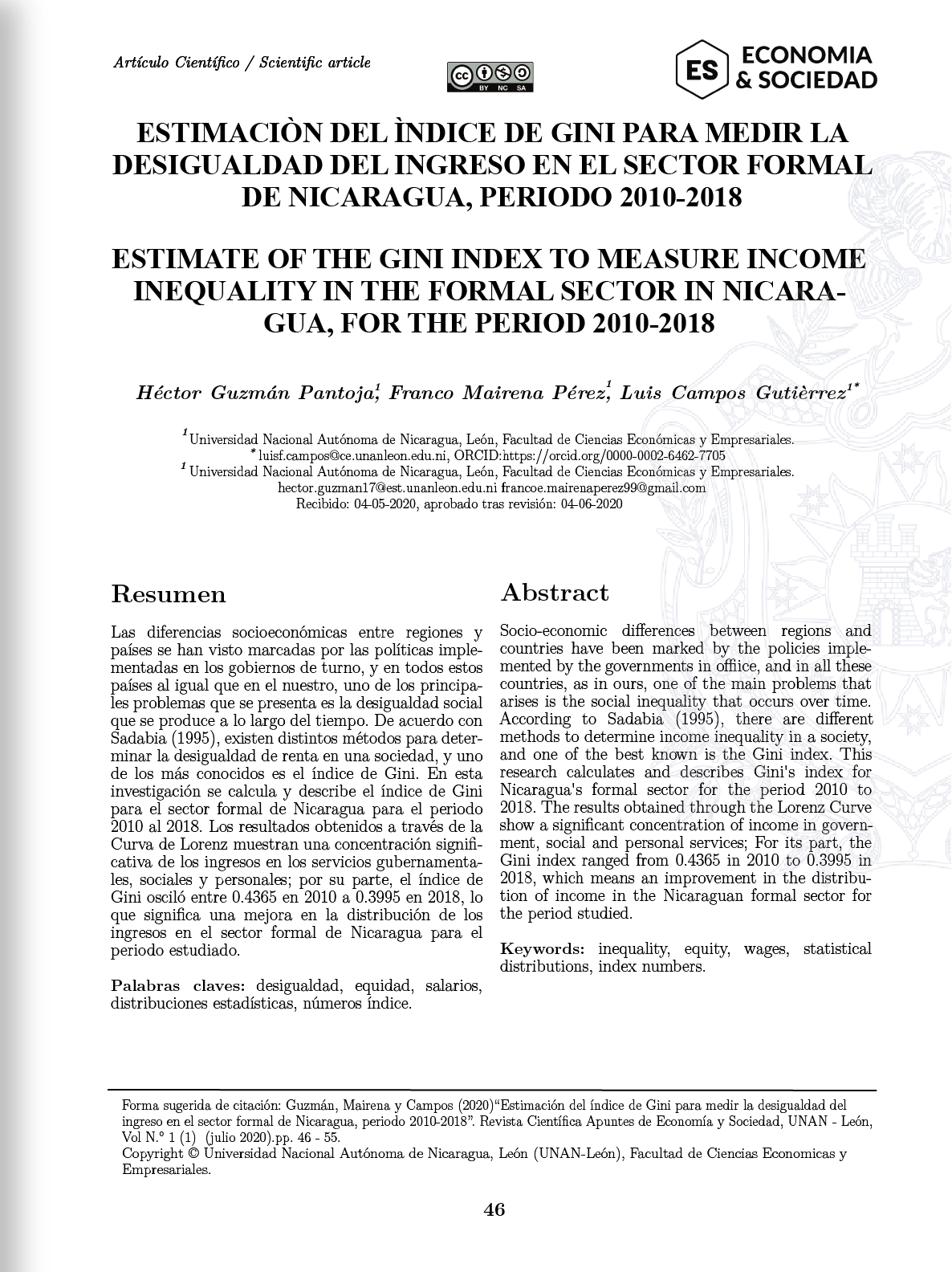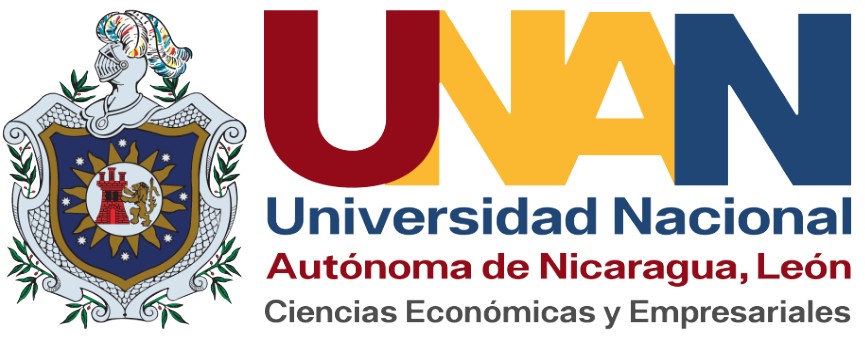Estimate of the Gini index to measure income inequality in the formal sector in Nicaragua, for the period 2010-2018
DOI:
https://doi.org/10.5377/aes.v1i1.11439Keywords:
inequality, equity, wages, statistical distributions, index numbersAbstract
Socio-economic differences between regions and countries have been marked by the policies implemented by the governments in office, and in all these countries, as in ours, one of the main problems that arises is the social inequality that occurs over time. According to Sadabia (1995), there are different methods to determine income inequality in a society, and one of the best known is the Gini index. This research calculates and describes Gini's index for Nicaragua's formal sector for the period 2010 to 2018. The results obtained through the Lorenz Curve show a significant concentration of income in government, social and personal services; For its part, the Gini index ranged from 0.4365 in 2010 to 0.3995 in 2018, which means an improvement in the distribution of income in the Nicaraguan formal sector for the period studied.
Downloads
References
Andradre, S., y Vidal, C. (2011). Análisis de la pobreza en el Ecuador a través del índice de Gini y la curva de Lorenz, período 2000-2010. Tesis, Cuenca. Obtenido de http://dspace.ucuenca.edu.ec/handle/123456789/1018
Avendaño, N. (06 de marzo de 2014). Blog de Nestor Avendaño Economia. Obtenido de https://nestoravendano.wordpress.com/2014/03/06/la-desigualdad-de-la-distribucion-del-ingreso-en-nicaragua/
Boltvinik, J. (1984). Satisfacción desigual de las necesidades esenciales en México. Mexico: Editorial Siglo Veintiuno. Obtenido de http://www.julioboltvinik.org/wp-content/uploads/CAPITULOS_LIBRO_1/satisfaccion_desigual_de_las_necesidades_esenciales_en_mexico.pdf
Hernández, R., Fernandez , C., y Baptista, P. (2014). Metodologia de la investigacion (5ta ed.). (J. M. Chacón, Ed.) México, México: McGRAW-HILL / INTERAMERICANA EDITORES, S.A. DE C.V. Obtenido de https://www.esup.edu.pe/descargas/dep_investigacion/Metodologia%20de%20la%20investigaci%C3%B3n%205ta%20Edici%C3%B3n.pdf
INIDE. (2011). Anuario Estadistico. Instituto Nacional de Información de Desarrollo, Managua, Nicaragua. Obtenido de http://www.inide.gob.ni/Publi_INIDE/Anuarios.html
INIDE. (2016). Anuario Estadistico. Instituto Nacional de Infromacion de Desarrollo, Managua, Nicaragua. Obtenido de http://www.inide.gob.ni/Publi_INIDE/Anuarios.html
Jusidman, C. (2009). Desigualdad y politica social en Mexico. Revista nueva sociedad(en linea). Obtenido de http://www.nuso.org/upload/articulos/3602_1.pdf
Keynes, J. M. (1965). Teoria General de la Ocupacion, el Interés y el Dinero. Obtenido de http://www.eumed.net/textos/06/Keynes%20-%20Teoria%20General%20-%20Parte%201.htm
Mankiw, G. N. (2014). Macroeconomía. Nueva York: Worth Publisher.
Parkin, M. (2004). Economia (Sexta ed.). (E. Quintanar, Ed., & I. Pearson Education, Trad.) M'éxico, México: Pearson Education, Inc. Recuperado el 09 de septiembre de 2019, de https://books.google.com.ni/books?id=31L6QKGRFtEC&pg=PA346&lpg=PA346&dq=la+riqueza+es+un+acopio+de+activos+y+el+ingreso+es+el+flujo+de+ganancias+que+proviene+de+dicho+acopio+de+activos%E2%80%9D.+pakin&source=bl&ots=avQ8TfSruC&sig=ACfU3U0s1OK1ubQW6_CJO1KZm
Pérez, J. y Merino, M. (2010). Definicion de:. Recuperado el 09 de septiembre de 2019, de https://definicion.de/distribucion/
Ray, D. (1998). Economia del Desarrollo. España: Editorial Antoni _Bosc. Obtenido de https://es.slideshare.net/reneroldanvillalobos/economa-del-desarrollo-debraj-ray
Sadabia, A. V. (1995). Estadística Descriptiva e Inferencial. COMPOBELL. S.L. Murcia. Obtenido de https://books.googleusercontent.com/books/content?req=AKW5QaeXtbnpaSC2YA_JXYCxYtJZUB-4PwgjD5OpgNSYETZtxhNKMMkwMNF91HBLVK_mX-akGixRVhFXLOdZoZ782c5IuWX7KPTceABIyBXHr0WG1AJoq76tl-2m7u-
Soto, A. L. (2010). La desigualdad del ingreso y el papel del sector informal en la ciudad de Oaxaca de Juárez 1980-2003 (Tercera ed.). México: Printed in Mexico.
Urbaneta, L. (1977). Distribución del ingreso: analisis del caso venezolano caracas. Tesis, Caracas. Obtenido de http://www.sidalc.net/cgi-bin/wxis.exe/?IsisScript=IEL.xis&method=post&formato=2&cantidad=1&expresion=mfn=002238

Published
How to Cite
Issue
Section
License
Copyright (c) 2020 National Autonomous University of Nicaragua, UNAN León

This work is licensed under a Creative Commons Attribution-NonCommercial-ShareAlike 4.0 International License.













